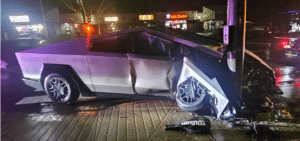
The Tesla Cybertruck, one of the most anticipated electric vehicles of the decade, has once again found itself in the spotlight—but this time for reasons that have sparked heated discussions online. A recent crash involving the Cybertruck, reportedly while operating on Tesla’s Full Self-Driving (FSD) V13 software, has gone viral, raising questions about the safety and reliability of autonomous driving technology.
What Happened in the Tesla Cybertruck Crash?
According to reports, the incident occurred during a routine drive on a public road. The Cybertruck was allegedly in Full Self-Driving mode when it collided with another vehicle. While details about the crash remain limited, eyewitnesses claim the Tesla’s autonomous system failed to detect the other car, leading to the accident.
The crash was captured on video and quickly spread across social media platforms, with many users expressing concerns about the safety of Tesla’s FSD technology. The video has since garnered millions of views, reigniting the debate over the readiness of self-driving systems for public roads.
Tesla’s Full Self-Driving V13: A Step Forward or a Cause for Concern?
Tesla’s Full Self-Driving V13 is the latest iteration of the company’s autonomous driving software. Elon Musk has touted it as a significant upgrade, promising improved navigation, better decision-making, and enhanced safety features. However, this incident has cast doubt on whether the technology is truly ready for widespread use.
Critics argue that while Tesla’s FSD system is impressive, it still has limitations, particularly in complex driving scenarios. Supporters, on the other hand, point out that no autonomous system is perfect and that incidents like these are part of the learning process for AI-driven technologies.

Public Reaction and Safety Concerns
The viral nature of the crash has led to a mixed response from the public. Some are calling for stricter regulations on autonomous vehicles, while others believe that such incidents are inevitable as the technology evolves.
Safety advocates have emphasized the need for more rigorous testing and transparency from Tesla regarding the capabilities and limitations of its FSD software. Meanwhile, Tesla owners and enthusiasts have defended the company, highlighting the overall safety record of its vehicles compared to traditional cars.
What This Means for the Future of Autonomous Driving
The Tesla Cybertruck crash on FSD V13 serves as a reminder of the challenges facing the autonomous vehicle industry. While self-driving technology has made significant strides, incidents like this underscore the importance of continued development, testing, and public education.
As Tesla and other automakers push forward with autonomous driving systems, the balance between innovation and safety will remain a critical topic. For now, the viral crash has reignited the conversation about how soon—and how safely—self-driving cars will become a mainstream reality.
FAQ
What is the Tesla Cybertruck?
The Tesla Cybertruck is a new electric pickup truck made by Tesla. It’s a big step towards green cars and changes how we think about pickup trucks.
What are the key features of the Cybertruck?
The Cybertruck has a cool, futuristic look and is made of ultra-hard stainless steel. It’s fast, can carry a lot, and has a long battery life. Inside, it’s techy and comfy, with a focus on being safe and green.
How does the Cybertruck’s design differ from traditional pickup trucks?
The Cybertruck looks different, with sharp lines and new materials like ultra-hard stainless steel. It’s a bold move by Tesla to change the pickup truck game.
What are the Cybertruck’s performance capabilities?
The Cybertruck is a powerhouse. It has a long battery, quick start, and can go fast. It also has great towing and carrying abilities, thanks to its electric powertrain.
What are the Cybertruck’s key safety features?
Safety is key for the Cybertruck. It has armor glass, ultra-hard steel, and smart driver systems. These features make it safe and protect everyone inside.
How does the Cybertruck contribute to sustainability and environmental impact?
Being electric, the Cybertruck doesn’t pollute like gas trucks do. It’s also made with green materials and Tesla cares about the planet. This makes it better for the environment.
What is the production timeline and manufacturing process for the Cybertruck?
Tesla is always improving its factories to make the Cybertruck efficiently. They’ve faced some issues but are working hard to get the truck to customers on time.
How does the Cybertruck compare to other electric pickup trucks in the market?
The Cybertruck is a new player in the electric truck market. Its unique design and Tesla’s reputation give it an edge. But, it will also face competition from other brands.
What are some of the real-world applications and use cases for the Cybertruck?
The Cybertruck is versatile and can be used in many ways. It’s great for work, fun, and city life. It shows how electric trucks can be useful and green.
What is the pricing structure and available options for the Cybertruck?
The Cybertruck is priced to be affordable, making electric cars more accessible. Tesla offers different models to fit various needs and tastes.
What has been the market response to the Cybertruck?
The Cybertruck has sparked a lot of interest, with many pre-orders. People are excited and hopeful about its impact on the truck market and the environment.
Disclaimer: The information provided in this article is based on publicly available reports and social media content. The details of the Tesla Cybertruck crash involving Full Self-Driving V13 are still emerging, and Tesla has not released an official statement at the time of writing. This article is for informational purposes only and does not constitute professional advice or an endorsement of any product or technology. Always rely on verified sources and exercise caution when interpreting viral content.